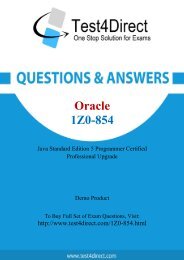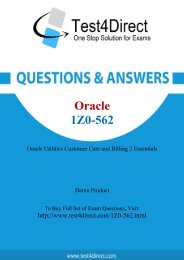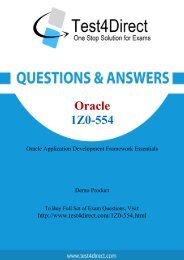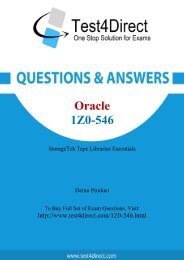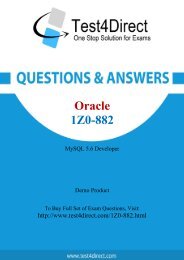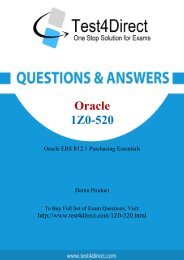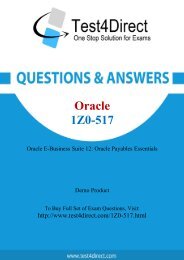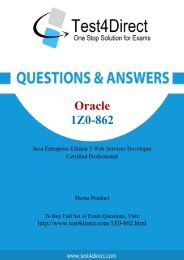Up-to-Date 1Z0-803 Exam BrainDumps for Guaranteed Success
Test4Direct provides latest PDF questions of Oracle 1Z0-803 exam. You have an opportunity to pass the Oracle 1Z0-803 exam in one go. Test4Direct is most accurate source to prepare Oracle 1Z0-803 exam as your success will become site’s responsibility after purchasing 1Z0-803 exam product. There are also lots of discounts and promotion offers that you can avail. Let’s try a free demo http://www.test4direct.com/1Z0-803.html
Test4Direct provides latest PDF questions of Oracle 1Z0-803 exam. You have an opportunity to pass the Oracle 1Z0-803 exam in one go. Test4Direct is most accurate source to prepare Oracle 1Z0-803 exam as your success will become site’s responsibility after purchasing 1Z0-803 exam product. There are also lots of discounts and promotion offers that you can avail. Let’s try a free demo http://www.test4direct.com/1Z0-803.html
You also want an ePaper? Increase the reach of your titles
YUMPU automatically turns print PDFs into web optimized ePapers that Google loves.
Oracle<br />
<strong>1Z0</strong>-<strong>803</strong><br />
Java SE 7 Programmer I<br />
Demo Product<br />
To Buy Full Set of <strong>Exam</strong> Questions, Visit:<br />
http://www.test4direct.com/<strong>1Z0</strong>-<strong>803</strong>.html
Question: 1<br />
Given the code fragment:<br />
int [] [] array2D = {{0, 1, 2}, {3, 4, 5, 6}};<br />
system.out.print (array2D[0].length+ "" );<br />
system.out.print(array2D[1].getClass(). isArray() + "");<br />
system.out.println (array2D[0][1]);<br />
What is the result?<br />
A. 3false1<br />
B. 2true3<br />
C. 2false3<br />
D. 3true1<br />
E. 3false3<br />
F. 2true1<br />
G. 2false1<br />
Answer: D<br />
Explanation:<br />
The length of the element with index 0, {0, 1, 2}, is 3. Output: 3<br />
The element with index 1, {3, 4, 5, 6}, is of type array. Output: true<br />
The element with index 0, {0, 1, 2} has the element with index 1: 1. Output: 1<br />
Question: 2<br />
View the exhibit:<br />
public class Student {<br />
public String name = "";<br />
public int age = 0;<br />
public String major = "Undeclared";<br />
public boolean fulltime = true;<br />
public void display() {<br />
System.out.println("Name: " + name + " Major: " + major);<br />
}<br />
public boolean isFullTime() {<br />
return fulltime;<br />
}<br />
}<br />
Given:<br />
Public class TestStudent {<br />
Public static void main(String[] args) {<br />
Student bob = new Student ();<br />
Student jian = new Student();<br />
bob.name = "Bob";<br />
bob.age = 19;<br />
jian = bob; jian.name = "Jian";
System.out.println("Bob's Name: " + bob.name);<br />
}<br />
}<br />
What is the result when this program is executed?<br />
A. Bob's Name: Bob<br />
B. Bob's Name: Jian<br />
C. Nothing prints<br />
D. Bob’s name<br />
Answer: B<br />
Explanation:<br />
After the statement jian = bob; the jian will reference the same object as bob.<br />
Question: 3<br />
Given the code fragment:<br />
String valid = "true";<br />
if (valid) System.out.println (“valid”);<br />
else system.out.println ("not valid");<br />
What is the result?<br />
A. Valid<br />
B. not valid<br />
C. Compilation fails<br />
D. An IllegalArgumentException is thrown at run time<br />
Answer: C<br />
Explanation:<br />
In segment 'if (valid)' valid must be of type boolean, but it is a string.<br />
This makes the compilation fail.<br />
Question: 4<br />
Given:<br />
public class ScopeTest {<br />
int z;<br />
public static void main(String[] args){<br />
ScopeTest myScope = new ScopeTest();<br />
int z = 6;<br />
System.out.println(z);<br />
myScope.doStuff();<br />
System.out.println(z);<br />
System.out.println(myScope.z);<br />
}<br />
void doStuff() {<br />
int z = 5;<br />
doStuff2();
System.out.println(z);<br />
}<br />
void doStuff2() {<br />
z=4;<br />
}<br />
}<br />
What is the result?<br />
A. 6 5 6 4<br />
B. 6 5 5 4<br />
C. 6 5 6 6<br />
D. 6 5 6 5<br />
Question: 5<br />
Question: 6<br />
Answer: A<br />
Explanation:<br />
Within main z is assigned 6. z is printed. Output: 6<br />
Within doStuff z is assigned 5.DoStuff2 locally sets z <strong>to</strong> 4 (but MyScope.z is set <strong>to</strong> 4), but in Dostuff z<br />
is still 5. z is printed. Output: 5<br />
Again z is printed within main (with local z set <strong>to</strong> 6). Output: 6<br />
Finally MyScope.z is printed. MyScope.z has been set <strong>to</strong> 4 within doStuff2(). Output: 4<br />
Which two are valid instantiations and initializations of a multi dimensional array?<br />
A. int [] [] array 2D = { { 0, 1, 2, 4} {5, 6}};<br />
B. int [] [] array2D = new int [2] [2];<br />
array2D[0] [0] = 1;<br />
array2D[0] [1] = 2;<br />
array2D[1] [0] = 3;<br />
array2D[1] [1] = 4;<br />
C. int [] [] [] array3D = {{0, 1}, {2, 3}, {4, 5}};<br />
D. int [] [] [] array3D = new int [2] [2] [2];<br />
array3D [0] [0] = array;<br />
array3D [0] [1] = array;<br />
array3D [1] [0] = array;<br />
array3D [0] [1] = array;<br />
E. int [] [] array2D = {0, 1};<br />
Answer: B, D<br />
Explanation:<br />
In the Java programming language, a multidimensional array is simply an array whose components<br />
are themselves arrays.<br />
An unchecked exception occurs in a method dosomething()<br />
Should other code be added in the dosomething() method <strong>for</strong> it <strong>to</strong> compile and execute?
A. The Exception must be caught<br />
B. The Exception must be declared <strong>to</strong> be thrown.<br />
C. The Exception must be caught or declared <strong>to</strong> be thrown.<br />
D. No other code needs <strong>to</strong> be added.<br />
Question: 7<br />
Question: 8<br />
Answer: C<br />
Explanation:<br />
Valid Java programming language code must honor the Catch or Specify Requirement. This means<br />
that code that might throw certain exceptions must be enclosed by either of the following:<br />
* A try statement that catches the exception. The try must provide a handler <strong>for</strong> the exception, as<br />
described in Catching and Handling Exceptions.<br />
* A method that specifies that it can throw the exception. The method must provide a throws clause<br />
that lists the exception, as described in Specifying the Exceptions Thrown by a Method.<br />
Code that fails <strong>to</strong> honor the Catch or Specify Requirement will not compile.<br />
Given the code fragment:<br />
int b = 4;<br />
b -- ;<br />
System.out.println (-- b);<br />
System.out.println(b);<br />
What is the result?<br />
A. 2 2<br />
B. 1 2<br />
C. 3 2<br />
D. 3 3<br />
Explanation:<br />
Variable b is set <strong>to</strong> 4.<br />
Variable b is decreased <strong>to</strong> 3.<br />
Variable b is decreased <strong>to</strong> 2 and then printed. Output: 2<br />
Variable b is printed. Output: 2<br />
Given the code fragment:<br />
interface SampleClosable {<br />
public void close () throws java.io.IOException;<br />
}<br />
Which three implementations are valid?<br />
A. public class Test implements SampleCloseable {<br />
Public void close () throws java.io.IOException {<br />
/ / do something<br />
Answer: A
}<br />
}<br />
B. public class Test implements SampleCloseable {<br />
Public void close () throws Exception {<br />
/ / do something<br />
}<br />
}<br />
C. public class Test implementations SampleCloseable {<br />
Public void close () throws Exception {<br />
/ / do something<br />
}<br />
}<br />
D. public class Test extends SampleCloseable {<br />
Public void close () throws java.IO.IOException {<br />
/ / do something<br />
}<br />
}<br />
Question: 9<br />
Answer: D<br />
Explanation:<br />
To declare a class that implements an interface, you include an implements clause in the class<br />
declaration. One interface might extended another interface, but a class cannot extend an interface.<br />
Checked exceptions are subject <strong>to</strong> the Catch or Specify Requirement. All exceptions are checked<br />
exceptions, except <strong>for</strong> those indicated by Error, RuntimeException, and their subclasses.<br />
Given the code fragment:<br />
Int [] [] array = {{0}, {0, 1}, {0, 2, 4}, {0, 3, 6, 9}, {0, 4, 8, 12, 16}};<br />
Systemout.printIn(array [4] [1]);<br />
System.out.printIn (array) [1][4]);<br />
int [] [] array = {{0}, {0, 1}, {0, 2, 4}, {0, 3, 6, 9}, {0, 4, 8, 12, 16}};<br />
System.out.println(array [4][1]);<br />
System.out.println(array) [1][4]);<br />
What is the result?<br />
A. 4 Null<br />
B. Null 4<br />
C. An IllegalArgumentException is thrown at run time<br />
D. 4 An ArrayIndexOutOfBoundException is thrown at run time<br />
Answer: D<br />
Explanation:<br />
The first println statement, System.out.println(array [4][1]);, works fine. It selects the element/array<br />
with index 4, {0, 4, 8, 12, 16}, and from this array it selects the element with index 1, 4. Output: 4<br />
The second println statement, System.out.println(array) [1][4]);, fails. It selects the array/element<br />
with index 1, {0, 1}, and from this array it try <strong>to</strong> select the element with index 4. This causes an<br />
exception.
Output:<br />
4<br />
Exception in thread "main" java.lang.ArrayIndexOutOfBoundsException: 4<br />
Question: 10<br />
Given:<br />
public class DoCompare1 {<br />
public static void main(String[] args) {<br />
String[] table = {"aa", "bb", "cc"};<br />
<strong>for</strong> (String ss: table) {<br />
int ii = 0;<br />
while (ii < table.length) {<br />
System.out.println(ss + ", " + ii);<br />
ii++;<br />
}<br />
}<br />
How many times is 2 printed as a part of the output?<br />
A. Zero<br />
B. Once<br />
C. Twice<br />
D. Thrice<br />
E. Compilation fails.<br />
Answer: D<br />
Explanation:<br />
The <strong>for</strong> statement, <strong>for</strong> (String ss: table), is executed one time <strong>for</strong> each of the three elements in table.<br />
The while loop will print a 2 once <strong>for</strong> each element.<br />
Output:<br />
aa, 0<br />
aa, 1<br />
aa, 2<br />
bb, 0<br />
bb, 1<br />
bb, 2<br />
cc, 0<br />
cc, 1<br />
cc, 2
THANKS FOR TRYING THE DEMO OF OUR PRODUCT<br />
Visit Our Site <strong>to</strong> Purchase the Full Set of Actual <strong>1Z0</strong>-<strong>803</strong> <strong>Exam</strong> Questions With Answers.<br />
http://www.test4direct.com/<strong>1Z0</strong>-<strong>803</strong>.html<br />
We Also Provide Practice <strong>Exam</strong> Software That Simulates Real <strong>Exam</strong> Environment And Has<br />
Many Self-Assessment Features. Download Free Product Demo From:<br />
http://www.test4direct.com/<strong>1Z0</strong>-<strong>803</strong>.html<br />
Money Back Guarantee<br />
Check Out Our Cus<strong>to</strong>mer Testimonials






